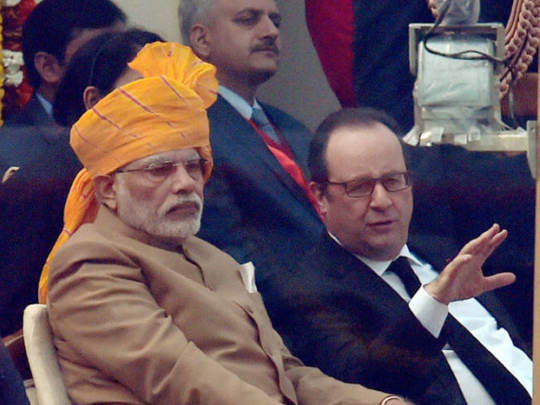
Indian Prime Minister Narendra Modi, as he bid a warm farewell to French President Francois Hollande, tweeted about the event to portray the Indo-French relationship as special; France had taken a nuanced position on India’s nuclear tests of 1998, unlike the US and the UK. And France is also the only country to be invited a record five times to India’s Republic Day parade. Undoubtedly, the French connection is strong.
The Memorandum of Understanding (MOU) on the Rafale fighter jet deal — the centrepiece in a recent extravagant display of public diplomacy — was signed along with a raft of other agreements. Despite the bonhomie, is the Rafale deal, one of the longest ongoing arms deals, any closer to the finish line? Rafale in French means ‘gust of wind’, but there is the dim possibility that this gust will be downgraded to a mere category 1 storm and bypass India.
It is the modest opinion of this columnist that hard questions on the deal have not been asked and the country should be prepared to pull out even at this stage if this exorbitant purchase is found to be unwanted. Indeed, these deliberations normally precede the tender process and possibly such a discussion has already taken place. If so, it is incumbent on the government to put it out in the public domain, because much of what happens with Rafale will have an irreversible impact on the country’s future strategic options.
This deal will leave a cataclysmic hole in India’s defence budget and without a full debate on why we need these fighter jets the public will be deeply suspicious of the country’s arms purchases. These issues need a wider scrutiny as they are fundamental in nature and are at the very heart of India’s military doctrine. They are at the very core of the country’s strategic thinking, especially for air operations; indeed how to harness its air power to safeguard its sky and mount a counteroffensive are so vital to the defence of the country that the public needs to be taken into confidence. If “war is too important to be left to the generals” then arms purchasing in today’s world is far too important to be left to just the fighter pilots who head up our air force, the upper echelons of the civil bureaucracy and politicians. Civil society and the wider strategic community need to be brought into these discussions.
Broadly, these troubling questions can be categorised under two different heads; one in the realm of strategic thinking including special relationships with countries such as Russia, the US and France, and the other largely commercial in pricing, technology transfer, off-set clauses, maintenance costs and guarantees of locally manufactured aircrafts. The head-to-head comparison between the competing jets is far too technical and it is assumed these technical aspects have gone into threadbare and so the potent question to be asked is does India actually need around 44 squadrons to guard its sky?
The IAF has repeatedly said that this amount is needed if India is to fight two wars simultaneously — with Pakistan and China — which incidentally India has never had to do despite the potential threat of such an eventuality. For purely comparison purposes, the US has around 70 odd squadrons with its responsibility as a global power, unlike India. The UK has seven, not a fair comparison but it does give a perspective to the 44 squadrons that India claims it needs.
Worldwide, the trend is to move away from staffed air platforms to unmanned aerial vehicles-UAV’s-and missiles. The IAF, in sequestering the portentous 44, seemed to have been trapped in the traditionalist mind-set that has always believed the fighter command is supreme — with the pilot at its helm — and that UAVs and missiles are of lesser consequence.
Ironically, the missile programme and UAV’s are largely in control of the army and not with the air force; and India is far from creating a robust strategic command on account of interservices differences and unwanted civilian and political fears. In short, it would appear that the upper echelons of the air force have wilfully or otherwise chosen to completely overlook other vital elements of air warfare that are so much a part of today’s military doctrine.
The comparisons between the French Rafale and the Russian Sukhois Su-30MKI, the Euro fighter Typhoon and American F22s and Swedish Grippen have been discussed, as has the dissection of the commercial terms of the deal, hence it is best avoided here. However, Russia’s belated offering of a cutting edge Sukhoi T-50/PAK-FA, a fifth generation fighter, bears mention, as it does present obstacles for the Rafale. Besides, Russia has always been the mainstay for India’s arms purchases because, unlike the West, Russians have resisted the sanctions regime imposed on and off on India. Sukhoi T-50/PAK-FA, however, is still undergoing trails unlike the Rafale, which is in production though it is rated as a 4.5 generation fighter. Russians, unsurprisingly, scoff at the Rafale and remember India will be the first large buyer in the world for these fighter jets.
The question is will India’s wider strategic community step up to weaken that gust blowing from France?









